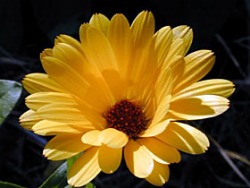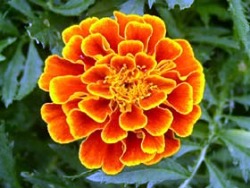
The French hybrid marigolds have vibrant colored flowers on short, compact plants.

Calendulas have beautiful daisy-like flowers that are tasty in salads and teas.
Marigolds (Tagetes spp.) are North American native flowers that were revered by the Aztecs in Mexico, who used them in religious ceremonies, as an ornamental, and as a medical plant. They were said to relieve hiccups and the effects of being struck by lightning. No wonder they were considered magical plants.
It was the Aztecs who introduced marigolds to Spanish and Portuguese explorers. Once the seeds made it to Spain, they quickly spread throughout Europe and North Africa. In Europe the plants were called "Mary's gold," referring to the brightly colored flowers and the Virgin Mary. The tall varieties we call African marigolds were bred in North Africa. Marigolds have since circled the globe. They are used in India and Pakistan as dyes, food, and to make flower garlands as part of harvest festivals. They finally made it back to the Americas as hybrids. Most marigolds we grow are a cross between tall African (T. erecta) and dwarf French (T. patula) varieties.
Marigolds are a “sure thing” annual flower. Once established, they will bloom all summer and actually make a great fall annual, bringing color to a garden when little else is still blooming. Plus, the flowers and buds are edible, having a somewhat citrus-like flavor. 'Lemon Gem' (T. tenuifolia) is considered one of the best tasting marigold varieties.
Although not botanically related to marigolds, calendula (Calendula officinalis) is called "pot marigold" because its bright yellow flower petals resemble marigolds. It was used during Tudor times as a poor man's saffron in cooking. Calendula is native to the Mediterranean, but like marigolds, has spread throughout the world. It is used medicinally to treat wounds and sores.
PlanningA number of of annual and perennial plants bearing the common name of “marigold,” such as marsh marigold (Caltha palustris) and tree or desert marigold (Baileya multiradiata), won't be covered here. I'm going to focus on the annual flowers most gardeners are familiar with, species and cultivars of the genus Tagetes. There has been much hybridizing of marigolds over the years to produce larger, multi-colored flowers and various sized, vigorous plants. Many marigold varieties are now offered as mixes with flower colors ranging from light yellow to deep gold to red.
Here are some varieties of marigolds to try in your garden.
'Bonanza Mix Hybrid' – This French marigold produces 2-inch crested flowers on 10 inch tall plants. Flower colors range from yellow to deep orange and red.
'Flagstaff Hybrid' – A creeping selection that grows well in window boxes and containers, this variety features highly fragrant leaves.
'Inca II Hybrid' – A unique, upright variety that features green leaves with yellow on the edges. It is highly ornamental as well as well as tasty.
'Lemon Gem' – This fast growing, creeping variety produces flowers in late summer and fall.
'Vanilla Improved Hybrid' – An upright variety that was bred especially for its production of flowers.
'Zenith Hybrid' – This upright bush is known for the pine scent from its leaves. The fine needles make this shrub look like a miniature Christmas tree.
'Bon Bon Hybrid' – Also known as 'Majorca', this upright rosemary has unusual pink flowers and thin, needle-like leaves.
'Flashback Mix' – This early-flowering, upright variety is known for its dense flowering habit.
Planting
Marigold flowers should be deadheaded in summer to keep them producing until frost.

Mix and match marigolds and calendulas with other flowers, such as verbena, to create a beautiful, edible landscape.
Start marigolds from seed or transplants and plant in full sun on well drained fertile soil. Calendulas are more shade tolerant. Seeds started indoors 6 to 8 weeks before the last frost date and plants purchased from garden centers will bloom sooner than those directly sown in the garden.
After all danger of frost has passed sow seed or transplants in the garden. Thin seedlings and space tall marigold varieties 2- to 3-feet apart and shorter varieties 1-foot apart. Dwarf marigolds and calendulas make excellent container and window box plants.
CareMarigolds and calendulas are forgiving of low fertility soils. In fact, too much compost or fertilizer will result in large plants with delayed flowering. Keep plants well watered. Large flowered double varieties may develop blossom rot during periods of wet weather. Deadhead all marigolds regularly to promote the most flowering.
Marigolds and calendula are vigorous self sowers, so don't be surprised to find seedlings scattered throughout your garden the following spring if you let some flowers go to seed. The seedlings probably will not have the same vigor and flower size as their parents, but still can be nurtured to produce flowers in your garden.
While folklore has it that marigolds repel a number of insects and should be interplanted with herbs and vegetables to protect plants, the only proven pest marigolds repel are soil dwelling nematodes. French marigolds are thought to be the best at repelling some types of nematodes. The most effective way to grow them as nematode repellents is to plant a thick stand of marigolds, grow them for 3 to 4 months and the till them under like a green manure crop. They are not as effective if simply interplanted around other crops.
Marigolds and calendulas do have some pests that attack them. During periods of dry weather spider mites can infest and kill plants. Keep the plants well watered and spray insecticidal soap to control this pest. Slugs love marigold and calendula seedlings, especially during cool wet periods. Spread slug baits and cultivate frequently around plants to keep these pests at bay.
HarvestHarvest marigold and calendula flowers as they open in late morning for garlands, cut flowers, and edible flowers for salads, cakes, and teas. Marigolds and calendulas are easy to dry and store for later use. Spread the flowers on a screen to dry in a well-ventilated, shady location and store in glass jars. You can remove the seeds and store them, too, for sowing next spring.
Other marigold and calendula stories:Fine French Marigolds
A Calendular Surprise
Mari-Mums for Fall Color
 Charlie Nardozzi is an award winning, nationally recognized garden writer, speaker, radio, and television personality. He has worked for more than 30 years bringing expert gardening information to home gardeners through radio, television, talks, tours, on-line, and the printed page. Charlie delights in making gardening information simple, easy, fun and accessible to everyone. He's the author of 6 books, has three radio shows in New England and a TV show. He leads Garden Tours around the world and consults with organizations and companies about gardening programs. See more about him at Gardening With Charlie.
Charlie Nardozzi is an award winning, nationally recognized garden writer, speaker, radio, and television personality. He has worked for more than 30 years bringing expert gardening information to home gardeners through radio, television, talks, tours, on-line, and the printed page. Charlie delights in making gardening information simple, easy, fun and accessible to everyone. He's the author of 6 books, has three radio shows in New England and a TV show. He leads Garden Tours around the world and consults with organizations and companies about gardening programs. See more about him at Gardening With Charlie.
 Victory Seed Company has all the seeds you want for your best garden in 2024.
Victory Seed Company has all the seeds you want for your best garden in 2024.
For 25 years, the family-owned Victory Seed Company has provided the highest quality vegetable, herb and flower seeds to families across the country. We are passionate about providing you the best seeds available that give excellent germination, robust plants, and the harvest you want. With a catalog of over a thousand varieties, we have everything, and our prices are the kinds that we'd want to pay. We have hundreds of yesterday's heirloom vegetables, as well as today's award winning hybrid selections. Get to know us by visiting our website and browsing through our online vegetable seed catalog.